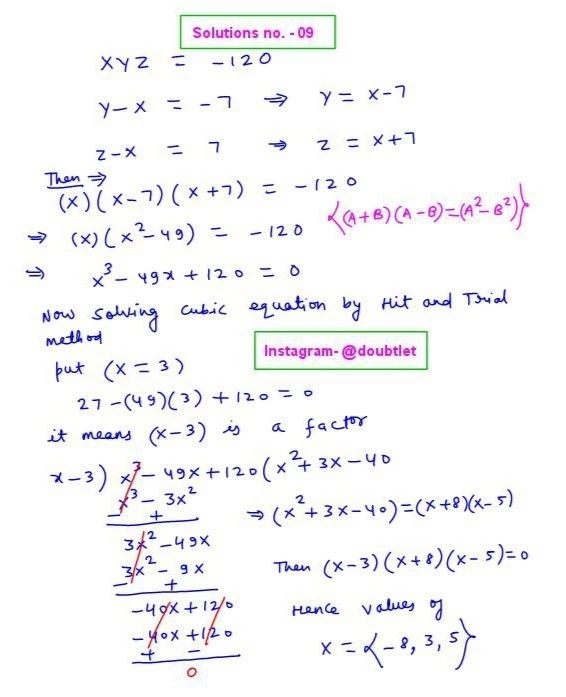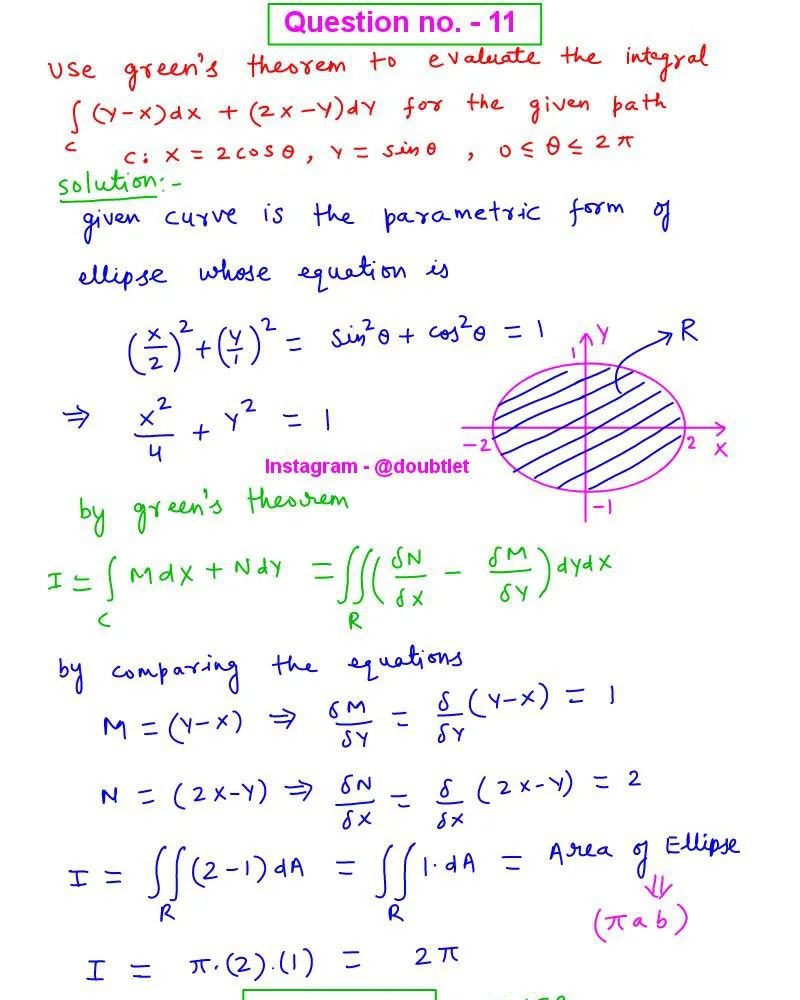Neetesh Kumar | October 27, 2024
Differential Equation Homework Help
This is the solution to Math 2A, section 13Z, Fall 2023 | WebAssign Math002ACh4Sec06 (Homework) Question - 2 Contact me if you need help with Homework, Assignments, Tutoring Sessions, or Exams for STEM subjects. Testimonials or Vouches from here of the previous works I have done.
Get Homework Help
Step-by-step solution:
To solve the differential equation y ′ ′ + y = sin 2 ( x ) y'' + y = \sin^2(x) y ′′ + y = sin 2 ( x )
Step 1: Solve the Homogeneous Equation
The associated homogeneous equation is:
y ′ ′ + y = 0 y'' + y = 0 y ′′ + y = 0
The characteristic equation for this differential equation is:
r 2 + 1 = 0 r^2 + 1 = 0 r 2 + 1 = 0
Solving for r r r r = ± i r = \pm i r = ± i
Thus, the solutions to the homogeneous equation are:
y h ( x ) = C 1 cos ( x ) + C 2 sin ( x ) y_h(x) = C_1 \cos(x) + C_2 \sin(x) y h ( x ) = C 1 cos ( x ) + C 2 sin ( x )
Step 2: Rewrite the Non-Homogeneous Term
We are given a non-homogeneous term sin 2 ( x ) \sin^2(x) sin 2 ( x ) sin 2 ( x ) \sin^2(x) sin 2 ( x )
sin 2 ( x ) = 1 − cos ( 2 x ) 2 \sin^2(x) = \frac{1 - \cos(2x)}{2} sin 2 ( x ) = 2 1 − c o s ( 2 x )
Thus, the equation becomes:
y ′ ′ + y = 1 2 − 1 2 cos ( 2 x ) y'' + y = \frac{1}{2} - \frac{1}{2} \cos(2x) y ′′ + y = 2 1 − 2 1 cos ( 2 x )
This allows us to split the problem into solving two separate equations. We write the particular solution as:
y p ( x ) = y p 1 ( x ) + y p 2 ( x ) y_p(x) = y_{p1}(x) + y_{p2}(x) y p ( x ) = y p 1 ( x ) + y p 2 ( x )
where:
y p 1 ′ ′ + y p 1 = 1 2 y_{p1}'' + y_{p1} = \frac{1}{2} y p 1 ′′ + y p 1 = 2 1 y p 2 ′ ′ + y p 2 = − 1 2 cos ( 2 x ) y_{p2}'' + y_{p2} = -\frac{1}{2} \cos(2x) y p 2 ′′ + y p 2 = − 2 1 cos ( 2 x )
Step 3: Solve for y p 1 ( x ) y_{p1}(x) y p 1 ( x )
For the first part, we solve y p 1 ′ ′ + y p 1 = 1 2 y_{p1}'' + y_{p1} = \frac{1}{2} y p 1 ′′ + y p 1 = 2 1
Since the right side is a constant, we can try a constant solution, y p 1 = A y_{p1} = A y p 1 = A A A A
0 + A = 1 2 0 + A = \frac{1}{2} 0 + A = 2 1
Thus, A = 1 2 A = \frac{1}{2} A = 2 1
y p 1 ( x ) = 1 2 y_{p1}(x) = \frac{1}{2} y p 1 ( x ) = 2 1
Step 4: Solve for y p 2 ( x ) y_{p2}(x) y p 2 ( x )
Now we solve y p 2 ′ ′ + y p 2 = − 1 2 cos ( 2 x ) y_{p2}'' + y_{p2} = -\frac{1}{2} \cos(2x) y p 2 ′′ + y p 2 = − 2 1 cos ( 2 x )
Since the solutions to the homogeneous equation are cos ( x ) \cos(x) cos ( x ) sin ( x ) \sin(x) sin ( x )
y p 2 ( x ) = u 1 ( x ) cos ( x ) + u 2 ( x ) sin ( x ) y_{p2}(x) = u_1(x) \cos(x) + u_2(x) \sin(x) y p 2 ( x ) = u 1 ( x ) cos ( x ) + u 2 ( x ) sin ( x )
where u 1 ( x ) u_1(x) u 1 ( x ) u 2 ( x ) u_2(x) u 2 ( x )
For variation of parameters, we impose the conditions:
u 1 ′ ( x ) cos ( x ) + u 2 ′ ( x ) sin ( x ) = 0 u_1'(x) \cos(x) + u_2'(x) \sin(x) = 0 u 1 ′ ( x ) cos ( x ) + u 2 ′ ( x ) sin ( x ) = 0 − u 1 ′ ( x ) sin ( x ) + u 2 ′ ( x ) cos ( x ) = − 1 2 cos ( 2 x ) -u_1'(x) \sin(x) + u_2'(x) \cos(x) = -\frac{1}{2} \cos(2x) − u 1 ′ ( x ) sin ( x ) + u 2 ′ ( x ) cos ( x ) = − 2 1 cos ( 2 x )
Step 5: Set Up and Solve for u 1 ′ ( x ) u_1'(x) u 1 ′ ( x ) u 2 ′ ( x ) u_2'(x) u 2 ′ ( x )
The Wronskian W ( cos ( x ) , sin ( x ) ) W(\cos(x), \sin(x)) W ( cos ( x ) , sin ( x )) W = cos 2 ( x ) + sin 2 ( x ) = 1 W = \cos^2(x) + \sin^2(x) = 1 W = cos 2 ( x ) + sin 2 ( x ) = 1
Using Cramer’s rule, we find u 1 ′ ( x ) u_1'(x) u 1 ′ ( x ) u 2 ′ ( x ) u_2'(x) u 2 ′ ( x )
u 1 ′ ( x ) = ∣ 0 sin ( x ) − cos ( 2 x ) 2 cos ( x ) ∣ W = sin ( x ) cos ( 2 x ) 2 u_1'(x) = \frac{\begin{vmatrix} 0 & \sin(x) \\ -\frac{\cos(2x)}{2} & \cos(x) \end{vmatrix}}{W} = \frac{\sin(x) \cos(2x)}{2} u 1 ′ ( x ) = W 0 − 2 c o s ( 2 x ) sin ( x ) cos ( x ) = 2 s i n ( x ) c o s ( 2 x )
u 1 ′ ( x ) = ∣ cos ( x ) 0 − sin ( x ) − cos ( 2 x ) 2 ∣ W = − cos ( x ) cos ( 2 x ) 2 u_1'(x) = \frac{\begin{vmatrix} \cos(x) & 0 \\ -\sin(x) & -\frac{\cos(2x)}{2} \end{vmatrix}}{W} = -\frac{\cos(x) \cos(2x)}{2} u 1 ′ ( x ) = W cos ( x ) − sin ( x ) 0 − 2 c o s ( 2 x ) = − 2 c o s ( x ) c o s ( 2 x )
Step 6: Integrate to Find u 1 ( x ) u_1(x) u 1 ( x ) u 2 ( x ) u_2(x) u 2 ( x )
Integrate u 1 ′ ( x ) u_1'(x) u 1 ′ ( x ) u 2 ′ ( x ) u_2'(x) u 2 ′ ( x ) x x x
u 1 ( x ) = ∫ sin ( x ) cos ( 2 x ) 2 d x u_1(x) = \int \frac{\sin(x) \cos(2x)}{2} \, dx u 1 ( x ) = ∫ 2 s i n ( x ) c o s ( 2 x ) d x
So, u 1 ( x ) = 3 cos ( x ) − cos ( 3 x ) 12 u_1(x) = \frac{3\cos(x)-\cos(3x)}{12} u 1 ( x ) = 12 3 c o s ( x ) − c o s ( 3 x )
u 2 ( x ) = ∫ − cos ( x ) cos ( 2 x ) 2 d x u_2(x) = \int -\frac{\cos(x) \cos(2x)}{2} \, dx u 2 ( x ) = ∫ − 2 c o s ( x ) c o s ( 2 x ) d x
So, u 2 ( x ) = 3 sin ( x ) + sin ( 3 x ) 12 u_2(x) = \frac{3\sin(x)+\sin(3x)}{12} u 2 ( x ) = 12 3 s i n ( x ) + s i n ( 3 x )
Step 7: Form the Particular Solution y p ( x ) y_p(x) y p ( x )
y p ( x ) = y p 1 ( x ) + y p 2 ( x ) = 1 2 + y p 2 ( x ) y_p(x) = y_{p1}(x) + y_{p2}(x) = \frac{1}{2} + y_{p2}(x) y p ( x ) = y p 1 ( x ) + y p 2 ( x ) = 2 1 + y p 2 ( x )
Substitute u 1 ( x ) u_1(x) u 1 ( x ) u 2 ( x ) u_2(x) u 2 ( x ) y p 2 ( x ) = u 1 ( x ) cos ( x ) + u 2 ( x ) sin ( x ) y_{p2}(x) = u_1(x) \cos(x) + u_2(x) \sin(x) y p 2 ( x ) = u 1 ( x ) cos ( x ) + u 2 ( x ) sin ( x )
y p 2 ( x ) = ( 3 cos ( x ) − cos ( 3 x ) 12 ) cos ( x ) + ( 3 sin ( x ) + sin ( 3 x ) 12 ) sin ( x ) y_{p2}(x) = \left(\frac{3\cos(x)-\cos(3x)}{12}\right) \cos(x) + \left(\frac{3\sin(x)+\sin(3x)}{12}\right) \sin(x) y p 2 ( x ) = ( 12 3 c o s ( x ) − c o s ( 3 x ) ) cos ( x ) + ( 12 3 s i n ( x ) + s i n ( 3 x ) ) sin ( x )
Simplify each term:
y p 2 ( x ) = 1 4 − cos ( 2 x ) 12 y_{p2}(x) = \frac{1}{4} - \frac{\cos(2x)}{12} y p 2 ( x ) = 4 1 − 12 c o s ( 2 x )
so, y p ( x ) = 1 2 + 1 4 − cos ( 2 x ) 12 = 3 4 − cos ( 2 x ) 12 y_p(x) = \frac{1}{2} + \frac{1}{4} - \frac{\cos(2x)}{12} = \frac{3}{4} - \frac{\cos(2x)}{12} y p ( x ) = 2 1 + 4 1 − 12 c o s ( 2 x ) = 4 3 − 12 c o s ( 2 x )
Step 8: Write the General Solution
The general solution to the differential equation is:
y ( x ) = y h ( x ) + y p ( x ) y(x) = y_h(x) + y_p(x) y ( x ) = y h ( x ) + y p ( x )
where
y h ( x ) = C 1 cos ( x ) + C 2 sin ( x ) y_h(x) = C_1 \cos(x) + C_2 \sin(x) y h ( x ) = C 1 cos ( x ) + C 2 sin ( x )
and
y p ( x ) = 3 4 − cos ( 2 x ) 12 y_p(x) = \frac{3}{4} - \frac{\cos(2x)}{12} y p ( x ) = 4 3 − 12 c o s ( 2 x )
So,
y ( x ) = C 1 cos ( x ) + C 2 sin ( x ) + 3 4 − cos ( 2 x ) 12 y(x) = \boxed{C_1 \cos(x) + C_2 \sin(x) + \frac{3}{4} - \frac{\cos(2x)}{12}} y ( x ) = C 1 cos ( x ) + C 2 sin ( x ) + 4 3 − 12 cos ( 2 x ) Please comment below if you find any error in this solution. Youtube channel for video solutions to similar questions.















Leave a comment